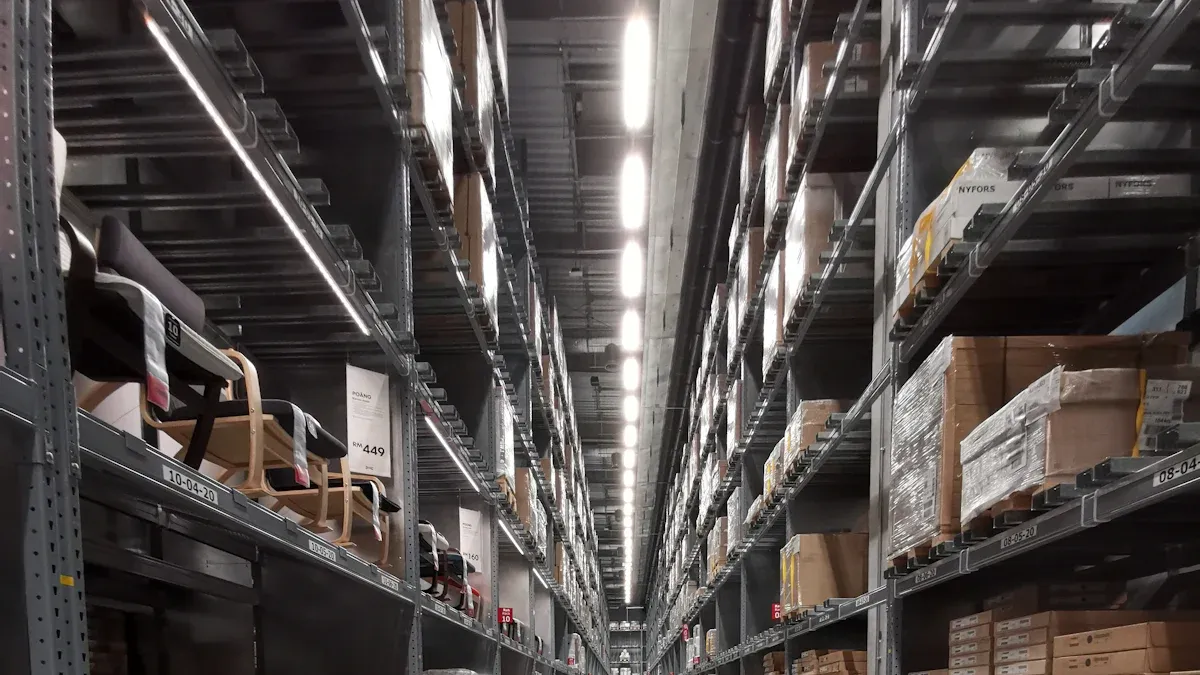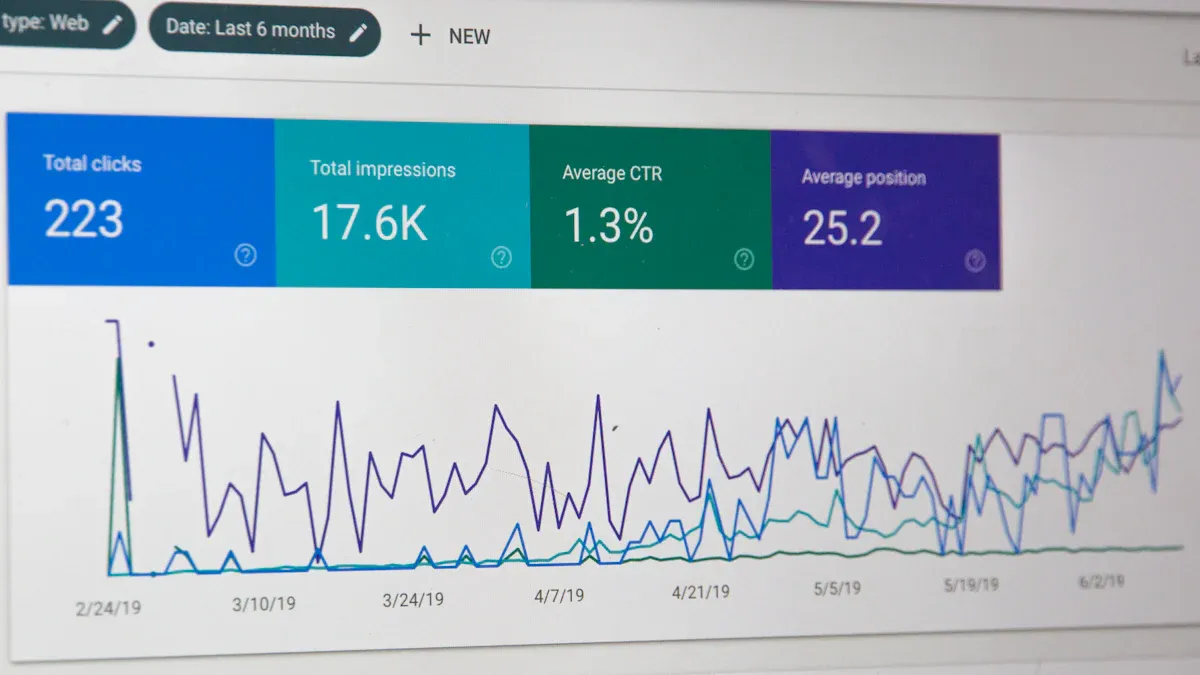Faster Turns Without Stockouts—Metrics & Actions

Balancing faster inventory turns with stockout prevention is vital for your business. When stockouts occur, they reduce customer service levels, causing lost sales and harming loyalty. High inventory costs can consume over 20% of sales, straining profitability. Faster turns, however, optimize inventory levels, cutting carrying costs and preventing losses from obsolescence. They also boost efficiency by streamlining operations and enhance customer satisfaction with better product availability. Using metrics and actions, you can align inventory management with demand, ensuring agility and a competitive edge in the market.
Key Takeaways
Keeping inventory moving fast while avoiding stockouts is important.
Use key numbers like turnover ratio and fill rate to check and improve inventory management.
Use better demand prediction methods to match stock with customer needs. This helps avoid running out or having too much stock.
Automate restocking to make it faster, more accurate, and efficient. This improves stock control.
Work well with suppliers and have more supplier options to shorten wait times and get deliveries on time.
Key Metrics for Faster Turns

Inventory Turnover Ratio
The inventory turnover ratio measures how often your inventory is sold and replaced within a specific period. It’s a critical metric for understanding the efficiency of your inventory management. A higher turnover ratio indicates faster inventory movement, reducing carrying costs and minimizing the risk of obsolescence.
For example, industries like grocery stores and fast fashion typically achieve high turnover ratios due to constant demand and frequent inventory refreshes. Grocery stores often see ratios between 20–50, while fast fashion can reach 30–60. On the other hand, industries like automobiles and heavy machinery have slower turnover rates, ranging from 2–4 and 1–2, respectively, due to longer production cycles and specialized products.
Industry | Inventory Turnover Ratio | Description |
|---|---|---|
Grocery Stores | 20–50 | High demand and perishable goods lead to quick turnover. |
Fast Fashion | 30–60 | Rapid trend changes necessitate constant inventory refresh. |
Automobiles | 2–4 | Customized configurations slow down turnover. |
Heavy Machinery | 1–2 | Specialized products lead to longer holding periods. |
Manufacturers using advanced MRP systems achieve inventory turnover rates that are 40% higher than industry averages. This improvement enhances working capital and reduces operating costs, making faster turns a reality for businesses.
Fill Rate
Fill rate measures the percentage of customer orders fulfilled from available stock. It’s a direct indicator of your ability to meet demand without stockouts. A higher fill rate improves customer satisfaction and reduces lost sales.
Efficient inventory management systems can significantly enhance fill rates. For instance:
Corrected bias methodologies improve fill rates to 0.72 and 0.76, ensuring better accuracy.
Traditional fill rate calculations often overestimate by up to 7%, leading to inefficiencies.
By adopting advanced systems, you can achieve more accurate estimations and reduce errors. This not only boosts your fill rate but also aligns inventory levels with demand, enabling faster turns while maintaining stock availability.
Days of Sales in Inventory (DSI)
Days of Sales in Inventory (DSI) calculates the average number of days your inventory remains unsold. Lower DSI values indicate quicker inventory turnover, while higher values suggest slower movement.
Different industries exhibit varying DSI trends based on their operational needs. Retail supermarkets, for instance, maintain a DSI of around 25 due to rapid turnover. Cosmetic stores, on the other hand, have a DSI of 87, reflecting slower sales cycles. Luxury goods often show higher DSI values because of exclusivity and limited demand.
Industry | Days of Sales in Inventory (DSI) |
|---|---|
Retail Supermarkets | 25 |
Cosmetic Stores | 87 |
Fast-Food Chains | Lower DSI due to rapid turnover |
Luxury Goods | Higher DSI due to slower sales |
Monitoring DSI helps you identify inefficiencies and optimize inventory levels. By reducing DSI, you can achieve faster turns and improve cash flow, ensuring your business remains agile and competitive.
Perfect Order Rate
Perfect Order Rate measures how often you deliver orders without errors. It includes factors like on-time delivery, accurate quantities, and damage-free shipments. A high perfect order rate reflects operational excellence and builds customer trust.
Improving this metric requires attention to multiple areas. For example:
Companies that focused on carrier metrics, such as on-time delivery and damage rates, saw significant improvements.
Employee training and partnerships with reliable warehouses enhanced order accuracy.
Technology and analytics helped identify and address root causes of order failures.
The results of these efforts can be transformative. Consider the following improvements achieved in operational settings:
Improvement Area | Metric/Result |
|---|---|
Past Due Orders | |
Order Entry Time | Decreased from 10 days to < 2 days |
Order-Entry Errors | Decreased by 22% |
Work-in-Process Inventory | Reduced from 6 weeks to 3 weeks |
Order-Entry Productivity | Increased by 39% |
By focusing on these areas, you can achieve a higher perfect order rate. This not only reduces inefficiencies but also ensures faster turns by streamlining your inventory processes.
Backorder Rate
Backorder Rate measures the percentage of orders delayed due to insufficient stock. A high backorder rate signals poor inventory planning and can frustrate customers. Reducing this rate is crucial for maintaining customer satisfaction and operational efficiency.
Several strategies can help you lower backorder rates:
Inventory Buffering: Maintaining a low safety stock prevents shortages and minimizes backorders.
Supplier Relationships: Strong communication with suppliers ensures timely deliveries and avoids disruptions.
Clear, Frequent Customer Communication: Keeping customers informed about potential delays builds trust and reduces dissatisfaction.
Refined inventory practices, such as these, can significantly reduce backorder rates. When you align inventory levels with demand, you not only lower backorders but also achieve faster turns. This balance ensures your business remains agile and competitive in the market.
Strategies to Achieve Faster Turns Without Stockouts

Improve Demand Forecasting
Accurate demand forecasting is the foundation of effective inventory management. By predicting customer demand, you can align your inventory levels to avoid overstocking or stockouts. Advanced forecasting methodologies, such as demand sensing, use real-time data to improve accuracy. For example, Procter & Gamble reduced forecast errors by 40% using demand sensing, while Samsung Electronics enhanced inventory management with similar techniques. Companies like PepsiCo and Dell have also reported significant improvements in forecast accuracy.
The financial impact of stockouts highlights the importance of demand forecasting. Stockouts not only lead to lost sales but also risk long-term customer attrition. Disappointed customers may choose not to return, and manufacturers failing to deliver on time may face penalties or lose future orders. Globally, out-of-stock situations in retail caused an estimated $1.2 trillion in lost sales in 2023. Businesses lose up to $1.7 trillion annually due to stockouts, emphasizing the need for precise demand forecasting.
To improve your forecasting, consider leveraging historical sales data, market trends, and advanced analytics. Regularly updating your forecasts ensures they remain relevant as market conditions change. By refining your demand forecasting, you can achieve faster turns while maintaining optimal stock levels.
Optimize Safety Stock Levels
Safety stock acts as a buffer to protect against unexpected demand spikes or supply chain disruptions. Optimizing safety stock levels ensures you maintain product availability without overstocking. Automated monitoring systems can track inventory in real time and alert you when stock falls below predetermined levels, preventing critical shortages.
Leading inventory management systems use advanced techniques to configure optimal safety stock levels. For instance:
Regularly reviewing and updating forecasts keeps safety stock relevant as market conditions evolve.
Incorporating uncertainty metrics, like the coefficient of variation (CV), helps identify products requiring higher safety stock due to demand variability.
Multi-echelon inventory optimization considers the entire supply chain network, strategically positioning inventory to reduce total safety stock while maintaining service levels.
Strategic product segmentation tailors safety stock strategies based on product characteristics, such as demand variability.
By implementing these strategies, you can balance stock availability with cost efficiency. This approach minimizes carrying costs while ensuring you meet customer demand, enabling faster turns without risking stockouts.
Reduce Supplier Lead Times
Supplier lead times directly impact your ability to maintain optimal inventory levels. Shorter lead times improve operational efficiency, allowing you to respond quickly to changes in demand. A McKinsey study found that a 10% reduction in lead time correlates with a 7% increase in profit. Reducing lead times also enhances inventory turn rates, helping you achieve faster turns.
Just-in-Time (JIT) inventory management is an effective way to minimize lead times. JIT aligns supplier deliveries with production needs, reducing the need for excess inventory. Strong supplier relationships also play a crucial role. By maintaining open communication and collaborating closely with your suppliers, you can ensure timely deliveries and avoid disruptions.
To further reduce lead times, consider diversifying your supplier base. Working with multiple suppliers reduces dependency on a single source and mitigates risks. Additionally, investing in technology, such as supply chain management software, can streamline procurement processes and improve visibility across your supply chain.
By focusing on reducing supplier lead times, you can enhance your inventory management processes. This not only improves efficiency but also ensures you maintain stock availability, keeping your business agile and competitive.
Automate Inventory Replenishment
Automating inventory replenishment transforms how you manage stock levels. By replacing manual processes with automated systems, you gain real-time visibility and reduce errors. Automation ensures faster turns by optimizing stock levels and minimizing delays in replenishment.
Here’s how automation compares to manual replenishment:
Metrics | Manual Replenishment | Automated Replenishment |
|---|---|---|
Speed | Slow due to manual tracking and order processing | Fast as systems operate in real time with minimal delays |
Error Rates | High, with frequent mistakes in stock counts and orders | Low, thanks to automation eliminating human errors |
Cost | Expensive because of labor and inefficiencies | Cost-efficient by reducing labor needs and optimizing resources |
Real-Time Data | Absent, relying on periodic checks | Available, offering continuous inventory visibility |
Automated systems offer several benefits:
Complete, real-time inventory control ensures accuracy in stock handling.
Higher stock availability reduces stockouts and meets customer demand.
Accurate recording eliminates human error, ensuring the right inventory levels.
Increased efficiency streamlines processes, reducing manual labor and boosting productivity.
Businesses that adopt automation often see significant improvements. For example, optimizing stock levels can reduce carrying costs by over 20%. Automation also minimizes stockouts, cutting lost sales opportunities by more than 40%. By automating replenishment, you can achieve faster turns while maintaining optimal inventory levels.
Tip: Start small by automating high-demand products. Gradually expand automation to other inventory categories as you see results.
Implement Just-in-Time (JIT) Inventory Practices
Just-in-Time (JIT) inventory practices focus on aligning stock levels with actual demand. Instead of holding excess inventory, you receive goods only when needed. This approach reduces carrying costs and improves efficiency, helping you achieve faster turns.
JIT offers several advantages:
Lower inventory levels reduce storage costs and free up capital.
Faster response times allow you to adapt to changing demand.
Reduced waste minimizes losses from obsolete or expired products.
To implement JIT successfully, you need strong supplier relationships. Reliable suppliers ensure timely deliveries, preventing disruptions. Diversifying your supplier base also reduces dependency on a single source, enhancing flexibility.
Technology plays a key role in JIT practices. Supply chain management software provides real-time visibility, helping you track inventory and coordinate deliveries. By leveraging JIT, you can streamline operations and maintain stock availability without overstocking.
Note: JIT works best in industries with predictable demand patterns. Evaluate your business needs before adopting this approach.
Leverage Data Analytics and AI
Data analytics and AI revolutionize inventory management by providing actionable insights. These technologies enhance demand forecasting, optimize stock levels, and improve operational efficiency.
Retailers like Walmart use real-time analytics to predict product demand. By analyzing data from multiple sources, they ensure product availability and minimize missed sales. AI further enhances inventory tracking by offering real-time data accuracy and reducing human error.
Here’s how AI benefits inventory management:
Machine learning models analyze past sales data to forecast demand for specific products.
Advanced analytics help adjust inventory levels effectively, reducing holding costs by up to 20%.
Real-time tracking improves inventory turnover, ensuring faster turns.
A manufacturing company implemented AI-driven models to optimize inventory. This resulted in a 20% reduction in holding costs and improved inventory turnover. By leveraging AI, you can align stock levels with demand and enhance operational agility.
Tip: Combine AI with historical sales data to refine demand forecasting and achieve better inventory control.
Overcoming Common Challenges
Managing Demand Uncertainty
Demand uncertainty can disrupt inventory management and lead to stockouts or overstocking. You can address this challenge by adopting advanced forecasting techniques. These methods use historical data and statistical models to estimate future demand. Sensitivity analysis helps you understand how changes in demand affect your inventory. Adjusting safety stock levels based on forecast accuracy ensures you maintain optimal stock availability.
Demand forecasting techniques rely on historical data to predict future trends.
Sensitivity analysis evaluates how inventory models respond to demand fluctuations.
Inventory optimization methods refine safety stock levels to match forecast accuracy.
By implementing these strategies, you can reduce the risks associated with demand uncertainty. This approach ensures your inventory aligns with market needs, improving operational efficiency and customer satisfaction.
Handling Slow-Moving Inventory
Slow-moving inventory ties up capital and increases carrying costs. Managing it effectively can improve profitability and streamline operations. You should identify slow-moving items and make rational decisions about their future. For example, consider discounting or bundling these products to clear them from your inventory.
Improved profitability results from freeing up capital and reducing storage costs.
Enhanced efficiency comes from optimizing inventory turnover and minimizing waste.
Strategic adaptation allows you to focus on products that meet current consumer demand.
Overcoming the sunk cost fallacy is essential. Holding onto slow-moving inventory because of past investments can harm your business. Instead, adapt to market changes and invest in products with higher demand.
Balancing Cost Efficiency with Stock Availability
Balancing cost efficiency and stock availability is critical for effective inventory management. Holding too much inventory increases carrying costs, while stockouts lead to lost sales and dissatisfied customers. The Economic Order Quantity (EOQ) model offers a solution. This model helps you determine the optimal order quantity to minimize total inventory costs.
Research shows that businesses achieve better results by balancing these factors. Effective inventory management ensures you meet customer demand without incurring excessive costs. By adopting strategies like EOQ, you can maintain this balance and keep your operations running smoothly.
Dealing with Supply Chain Disruptions
Supply chain disruptions can derail your inventory management efforts. These disruptions often result from unexpected events like natural disasters, geopolitical issues, or supplier failures. To maintain faster inventory turns without stockouts, you need proactive strategies to mitigate these risks.
Build a Resilient Supply Chain
A resilient supply chain helps you adapt to disruptions quickly. Diversify your supplier base to reduce dependency on a single source. Work with suppliers in different regions to minimize risks from localized events. Establish backup suppliers for critical products to ensure continuity during emergencies.
Tip: Regularly evaluate supplier performance to identify potential risks early.
Increase Supply Chain Visibility
Visibility across your supply chain allows you to detect issues before they escalate. Use technology like supply chain management software to monitor inventory levels, supplier performance, and transportation timelines. Real-time data helps you make informed decisions and adjust operations during disruptions.
Benefits of Supply Chain Visibility | Impact |
|---|---|
Early detection of delays | Prevents stockouts |
Improved communication | Strengthens supplier relationships |
Enhanced decision-making | Reduces operational downtime |
Develop Contingency Plans
Contingency plans prepare you for unexpected events. Create detailed action plans for scenarios like supplier delays, transportation disruptions, or demand spikes. Include steps for reallocating inventory, sourcing alternative suppliers, and communicating with customers.
Note: Test your contingency plans regularly to ensure they work effectively during real disruptions.
Collaborate with Partners
Strong partnerships improve your ability to handle disruptions. Share forecasts and inventory data with suppliers to align operations. Collaborate with logistics providers to optimize transportation routes and reduce delays.
By implementing these strategies, you can minimize the impact of supply chain disruptions. This ensures your inventory remains agile, enabling faster turns while maintaining stock availability.
Achieving faster turns while preventing stockouts is essential for maintaining operational efficiency and customer satisfaction. Effective inventory management reduces costs and ensures optimal stock levels.
The authors find that inventory is often held downstream in local markets at optimality. This approach minimizes disruptions and ensures customer demand is met, highlighting the benefits of aligning faster inventory turns with stockout prevention.
Metrics like inventory turnover and fill rate guide actionable strategies. Data analytics provides insights into demand patterns, enabling businesses to optimize stock levels and make informed decisions. For example, a retailer used historical sales data to anticipate demand before hurricanes, ensuring better stock management during peak periods.
Adopting a data-driven approach tailored to your needs enhances inventory control and profitability. By leveraging these strategies, you can achieve faster turns and maintain a competitive edge.
FAQ
What is the ideal inventory turnover ratio for my business?
The ideal ratio depends on your industry. For example:
Grocery stores: 20–50
Fast fashion: 30–60
Automobiles: 2–4
Monitor your ratio regularly. Compare it to industry benchmarks to identify areas for improvement.
Tip: Use advanced inventory systems to boost your turnover ratio.
How can I reduce stockouts without overstocking?
Focus on demand forecasting and safety stock optimization. Use real-time data to predict demand accurately. Automate replenishment processes to maintain optimal stock levels.
Note: Regularly review your inventory strategy to adapt to market changes.
What tools can help improve inventory management?
Consider tools like:
ERP Systems: Integrate inventory, sales, and supply chain data.
AI Analytics: Predict demand and optimize stock levels.
Inventory Management Software: Automate replenishment and track stock in real time.
Example: Walmart uses AI to enhance inventory accuracy and reduce stockouts.
How do I handle slow-moving inventory?
Identify slow-moving items using metrics like DSI. Offer discounts or bundle these products to clear them. Avoid the sunk cost fallacy by focusing on high-demand items.
Tip: Regularly analyze sales data to prevent overstocking slow-moving products.
Is Just-in-Time (JIT) inventory suitable for all businesses?
JIT works best for businesses with predictable demand and reliable suppliers. Evaluate your supply chain's stability before adopting JIT.
Reminder: Diversify your supplier base to reduce risks when using JIT practices.
See Also
Understanding Algorithms for Speedy Delivery Route Optimization
Effective Strategies for Weekly Retail Demand Forecasting
Identifying Workflow Bottlenecks Using Path and Goal Analysis
Creating A Data-Driven Stage-Gate Process For Retail Launches
Four Key Algorithms For Automating Large-Scale Replenishment

